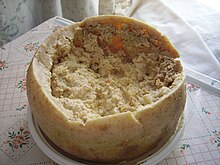
Back كاسو مارزو Arabic كاسو مارزو ARZ Casu marzu AST Casu marzu BAR Casu marzu Catalan Casu marzu Czech Casu Marzu German Κάζου μάρτζου Greek Casu marzu Spanish Casu marzu Finnish
| Casu martzu (Sardinian) Casgiu merzu (Corsican) Rotten cheese | |
|---|---|
 | |
| Country of origin | |
| Region | |
| Source of milk | Sheep |
| Pasteurised | No |
| Texture | Soft |
| Aging time | 3 months |
| Certification | None |
Casu martzu[1] (Sardinian: [ˈkazu ˈmaɾtsu]; lit. 'rotten/putrid cheese'), sometimes spelled casu marzu, and also called casu modde, casu cundídu and casu fràzigu in Sardinian, is a traditional Sardinian sheep milk cheese that contains live insect larvae (maggots).
Derived from pecorino, casu martzu goes beyond typical fermentation to a stage of decomposition, brought about by the digestive action of the larvae of the cheese fly of the Piophilidae family. These larvae are deliberately introduced to the cheese, promoting an advanced level of fermentation and breaking down of the cheese's fats. The texture of the cheese becomes very soft, with some liquid (called làgrima, Sardinian for "teardrop") seeping out. The larvae themselves appear as translucent white worms, roughly 8 mm (5⁄16 in) long.[2]
When consumed, the larvae can possibly survive in the intestine, causing enteric pseudomyiasis,[3][4] though no cases have been linked to the cheese.[5] Additionally, these larvae can carry harmful microorganisms that may lead to infections. Due to these risks, Italian authorities have banned the sale of this cheese, deeming it dangerous. Consequently, it is also prohibited across the European Union, as EU food safety regulations mandate that only food safe for consumption can be sold.[4]
Variations of this cheese also exist in Corsica, France, where it is called casgiu merzu,[6] and is especially produced in some Southern Corsican villages like Sartène.[7]
- ^ "Casu, Ditzionàriu in línia de sa limba e de sa cultura sarda". Regione Autònoma de Sardigna.
c. martzu = casu fatu, fatitadu, fatitu, giampagadu, cunnitu.
- ^ Berenbaum, May R (1993). Ninety-Nine More Maggots, Mites, and Munchers. University of Illinois Press. pp. 10–14. ISBN 0-252-06322-8.
- ^ Peckenscneider, L.E.; Polorny, C.; Hellwig, C.A. (17 May 1952). "Intestinal infestation with maggots of the cheese fly (Piophila casei)". JAMA. 149 (3): 262–263. doi:10.1001/jama.1952.72930200005011b. PMID 14927333.
- ^ a b "Subject: Petition No 0702/2023 presented by Nicolò Quartararo (Italian) on restoring the status of Casu Marzu cheese as a foodstuff and edible product in the EU" (PDF). European Parliament. 15 January 2024. Archived (PDF) from the original on 8 June 2024. Retrieved 8 June 2024.
- ^ Petroni. "Casu marzu: The world’s ‘most dangerous’ cheese", CNN Travel, 18 March 2021. Retrieved 24 March 2024.
- ^ Cazorla, Camille (2016). "Le casu marzu, le fromage (à larves) le plus dangereux du monde". Le Figaro.
le casu marzu qui signifie littéralement « fromage pourri » est originaire de Sardaigne, île méditerranéenne située au sud de la Corse. On l'y retrouve sous plusieurs appellations, casu modde, casu cundhidu, mais aussi en Italie, formaggio marcio, ou encore en Corse, sous le nom de casgiu merzu.
- ^ "Fromage corse: le Sartenais". Archived from the original on 1 May 2014. Retrieved 8 August 2014.